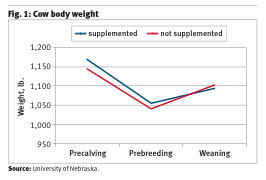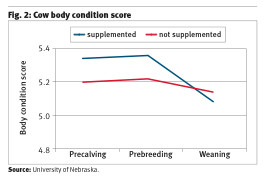
Rick Rasby
Ridin’ Herd
Grazing cornstalk residues: What do you need to supplement?
In many areas of the United States, cornstalk residue is available in the fall and winter for beef cows to graze. Allowing cows to harvest their nutrient needs is a lot more economical than carrying harvested forages to them. Grazing cornstalk residue is effective in reducing feed costs.
There are data from Nebraska and Iowa that indicate grazing corn residue in the fall and winter does not impact subsequent grain yield. If weather conditions in the spring make fields muddy, it may be advisable to remove cows from the fields. These weather conditions can occur in March in Nebraska.
Residue grazing is an important management practice for many cattle operations — primarily as either a winter feed resource for maintaining the breeding herd or putting weight on cull cows. A common question seems to be: Do I need to supplement the cows with something other than salt and mineral while they graze cornstalk residue?
How the nutrients stack up
Cows that graze cornstalk residue are selective grazers. They will select any corn or ears left in the field first, followed by the husks and the leaves, followed by the cobs and the stalks.
If you think about the quality of the nutrients left in the cornfield, the corn left behind is the most nutritious. Anymore, there is not a lot of eardrop left in a cornfield. The genetics developed over time have made the stalk stronger, and that has enabled the corn plant to stand up in very adverse conditions. In addition, technical advances in combines allow them to do a better job of harvesting the corn.
Most cornstalk fields we have grazed the past five to seven years have had less than 1.5 bushel (bu.) of corn per acre. If cornfields have more than 8 bu. per acre on the ground, extra management strategies will need to be implemented to avoid founder in cows grazing these fields.
Our data suggest the leaves in a cornstalk field will be between 48% and 62% total digestible nutrients (TDN), for an average of 58% TDN. So the leaves are very comparable to a medium- to high-quality grass hay. The protein content of the leaves will average 7%.
Husks are greater in energy content than the leaves, and tests indicate they can be as high as 60% TDN.
Interestingly, the cob is a good energy source, but the proportion of cob left in the field for cows to consume is about 11% of the remaining residue in a nonirrigated field and 12% in an irrigated field. So even though the energy content of the cob is good, it is not a very high component of the diet.
From a nutrient perspective, the stalk has the lowest nutrient profile. If cows have access to some corn, husk and leaves, they will select a diet that is close to 68% TDN.
Supplementation strategies
The reason for the previous discussion is to get at the possible supplementation needs. Cows have been grazing stalks for about a month now. Because there is not a lot of corn left in the field and it is likely cleaned up by now, producers may think they need to start supplementing cows something other than salt and mineral.
We designed an experiment where we supplemented cows protein early in the cornstalk-grazing period and then supplemented cows for both a protein and energy deficiency late in the grazing period. Our supplementation strategy was based on data collected by Wilson et al. and is reported in the 2004 Nebraska Beef Report. The TDN graph is reported on page 6.
The other set of cows received no supplementation other than salt and mineral while grazing cornstalk residue.
Both groups grazed fields that yielded 180 bu. of corn per acre. Eardrop was the same for the fields that were grazed and was less than 1.5 bu. per acre. Stocking rate was the same for both fields. All cows in this study were 3 years old or older. Body weight and body condition were the same after grazing stalks and before calving for both groups. Calf birth weight and pregnancy rates were similar for both groups.
These were March-calving cows. The stalk-grazing period varied each year due to weather conditions, but began in November and concluded in February.
 In a similar study reported in the 2009 Nebraska Beef Report, cows were grazing cornstalks and either supplemented daily with 1 pound (lb.) per head per day of a 28% protein supplement from Dec. 1 to the end of February each year or not supplemented. Stalk fields were similar, and cows calved in March. Figs. 1 and 2 depict weight and body condition score precalving, prebreeding and at weaning. The blue line represents protein-supplemented cows while grazing cornstalks, and the red line represents cows not supplemented while grazing.
In a similar study reported in the 2009 Nebraska Beef Report, cows were grazing cornstalks and either supplemented daily with 1 pound (lb.) per head per day of a 28% protein supplement from Dec. 1 to the end of February each year or not supplemented. Stalk fields were similar, and cows calved in March. Figs. 1 and 2 depict weight and body condition score precalving, prebreeding and at weaning. The blue line represents protein-supplemented cows while grazing cornstalks, and the red line represents cows not supplemented while grazing.
 In this data set there was no difference in weight or body condition at any of the three times the parameters were measured. Calf birth weight and calf performance to weaning were not different. Pregnancy rates for the subsequent breeding season were 97.7% and 95.3% for supplemented and nonsupplemented cows, respectively.
In this data set there was no difference in weight or body condition at any of the three times the parameters were measured. Calf birth weight and calf performance to weaning were not different. Pregnancy rates for the subsequent breeding season were 97.7% and 95.3% for supplemented and nonsupplemented cows, respectively.
These data sets would suggest that cornstalk residue is a good feed source for spring-calving cows. Other than salt and mineral, it appears that supplementation is not necessary. Remember, the stalk fields were not overstocked, and cows were not left on the fields more than the number of grazing days that were calculated using data that we developed.
Adhere to stocking rate
Sometimes producers tend to think that if the winter is "open" (snow-free), the stalks will always meet the cows' needs no matter how long they have been grazing the same field. This is not true.
Here is a quick way to calculate stocking rate for corn-residue fields. Our data suggest that there is 16 lb. of residue dry matter per bushel of corn. So for a 150 bu.-per-acre field, there is 2,400 lb. of leaf and husk available per acre on a dry-matter (DM) basis. If you plan to take half, and plan that about half will be trampled and not available for cows to harvest, then there is 1,200 lb. (50% of the total 2,400 lb.) of husk and leaf available for the animal on a DM basis. If a 1,200-lb. cow eats about 2% of her body weight daily on a DM basis, then an acre of stalks should feed a 1,200-lb. cow for 45-50 days (1,200 lb. of residue per acre divided by 24 lb. of intake per day for the 1,200-lb. cow). There is a cornstalk grazing calculator available.

Final thoughts
Crop residues provide producers an opportunity to reduce cow costs. After calving, cornstalk residue will not meet the nutritional needs of the lactating cow. Based on the data presented, salt and mineral are all that is needed as long as the stocking rate is at recommended levels. Consider saving money for supplements that may be needed when feeding harvested feedstuffs that don't meet the cow's nutrient needs.
[Click here to go to the top of the page.]





